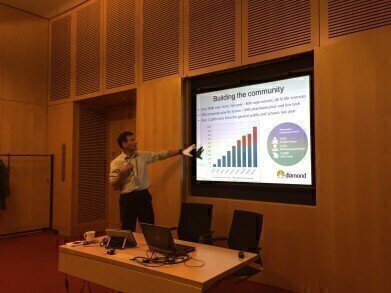-
 Andrew Harrison presenting at the annual review
Andrew Harrison presenting at the annual review
News & Views
National Facility aims to keep UK at Forefront of Science
Jun 29 2016
Diamond Light Source the UK’s national synchrotron science facility, has unveiled its strategy for growth over the next decade and highlighted key findings from the past year in areas such as antivirals, Osteoarthritis, the fight against Ebola, lithium ion batteries and fuel cell catalysts.
During its Annual Review Showcase, which took place at the Wellcome Trust in London (June 27) Andrew Harrison, Diamond’s CEO, said, “The past year has been incredibly productive with over 850 peer-reviewed journal articles published by our staff and user community. We have recently signed up our 100th industry customer, 3Dmagination and we are in the process of setting up state of the art facilities for electron microscopy for both the physical and life sciences.”
“By listening to the needs of our academic and industrial users, we have drawn up a development strategy that will ensure that we maintain our position as one of the best synchrotron facilities in the world. A national science facility that delivers world class science that impacts on society as a whole in a positive way. Today is about celebrating recent and upcoming successes in a week when Nature will publish significant results from Diamond on an Oxford led research project relating to a potential new treatment for diseases caused by the Ebola viruses. Looking ahead, we are working on plans to upgrade our storage ring and some of our beamlines, exploiting new technology that was not around when Diamond was built and went into operation almost 10 years ago.”
“Successful science is as much about who you are collaborating with as it is about the equipment you have access to. Diamond has a hugely dedicated team on both the science and the technical side and this has helped us secure long term collaborations with academia and industry. Our existing collaborations with universities such as Manchester, Imperial and Oxford and companies such as Johnson Matthey, Infineum and GSK bring benefits to both sides and to our wider user communities. We want to attract more collaborators to the Harwell Campus where they can benefits from our fantastic facilities and expertise, and also tap into other techniques and equipment available across the campus as a whole.”
A number of scientists presented on their Diamond related research and Neil Bourne, Director of the Diamond Manchester Collaboration, spoke about the growth plans for this joint partnership in the coming years.
Science presentations were given by Kamel Madi, University of Manchester and Katherine Staines from the Royal Veterinary College London and The University of Edinburgh. Together they are researching osteoarthritis (OA), a debilitating disease that is characterised by the loss of articular cartilage that normally covers the ends of bones to allow pain free movement, using synchrotron X-ray microtomography on the Diamond Manchester Imaging Branchline (I13-2). KA Staines et al. doi 10.1002/art.39508
Kamel Madi is also one of the scientists behind start-up company 3Dmagination, which recently became Diamond’s 100th industrial user. Kamel spoke about the aims of the company, which provides advanced services and custom-build training in 3D and 4D imaging to academics and companies.
Jonathan Grimes from the University of Oxford gave an update on his groups research into the way that influenza viruses replicate using a viral RNA polymerase. Understanding the structure of this polymerase is fundamental to understanding the mechanism of viral replication. Crystals of the polymerase were examined using the Macromolecular Crystallography beamlines (including I03, I04 and I24) to solve the structure, and the High Throughput SAXS beamline B21 to monitor the global conformational changes. 1
Zoe Schnepp from the University of Birmingham is working with colleagues on new designs for efficient fuel cell catalysts. Zoe presented research carried out on Diamond’s Powder Diffraction beamline (I11). This beamline allows investigation of the structural properties and behaviour of materials and is enabling researchers to develop iron carbide as a catalyst for fuel cells. 2
1 Hengrung N et al. https://ilmt.co/PL/knRE
2 Schnepp Z, et al. https://ilmt.co/PL/QbGy
For further information on this research and more published in Diamond’s 2015/16 Annual Review, please visit https://ilmt.co/PL/6B1l
Digital Edition
Lab Asia 31.2 April 2024
April 2024
In This Edition Chromatography Articles - Approaches to troubleshooting an SPE method for the analysis of oligonucleotides (pt i) - High-precision liquid flow processes demand full fluidic c...
View all digital editions
Events
Apr 25 2024 Istanbul, Turkey
Apr 28 2024 Montreal, Quebec, Canada
May 05 2024 Seville, Spain
InformEx Zone at CPhl North America
May 07 2024 Pennsylvania, PA, USA
May 14 2024 Oklahoma City, OK, USA

















